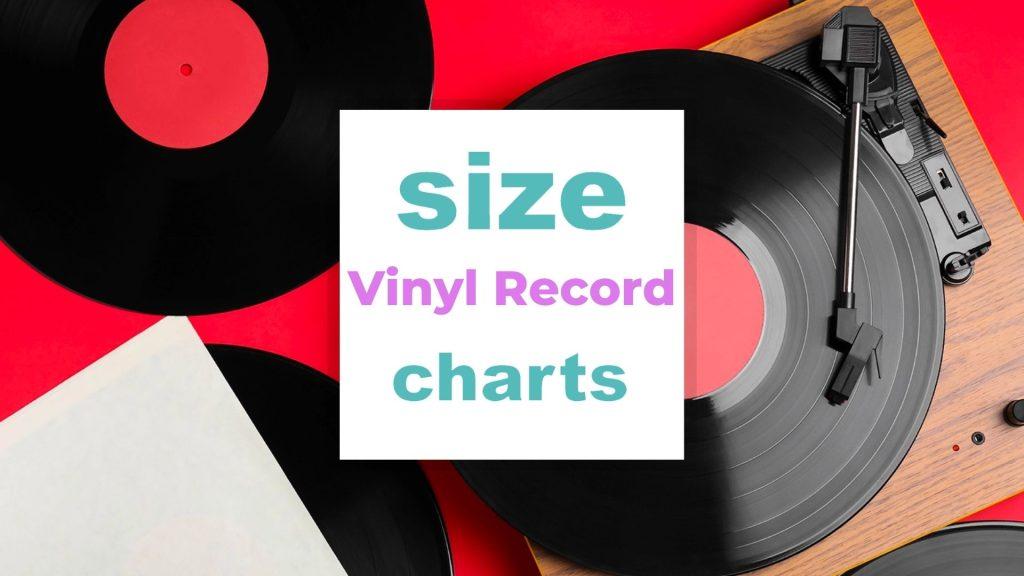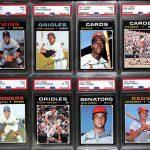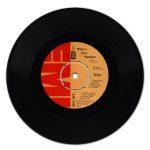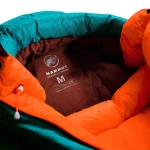Vinyl Record Size and Dimensions
Vinyl Records are a type of phonograph record that is played by spinning the disc on a turntable. The Needle or stylus is placed in the groove and vibrates, sending sound waves through the stylus to the amplifier and speaker. Vinyl records were first introduced in 1948 and became the dominant format for music listening in the 1970s (skip straight to the vinyl record size charts).
They are made of polyvinyl chloride (PVC) and can be played at a variety of speeds, including 33 1/3 RPM, 45 RPM, and 78 RPM. Vinyl records are considered to have a superior sound quality to digital formats like CDs and MP3s. They are also more durable than CDs and can be played hundreds of times without degradation. However, they are more susceptible to scratches and require special care when handling. Vinyl records are making a comeback in recent years as a result of the growing popularity of vintage music formats.

The most common size is the 12-inch album, which can hold up to an hour of music. This is the format that was used for most LPs released prior to the compact disc. The smaller 7-inch single is often used for singles and EPs, as well as some limited edition releases.
Finally, the 10-inch record is a middle ground between the two, and it’s becoming increasingly popular for indie and alternative releases. With so many options to choose from, it’s important to understand the differences before deciding which format is right for you.
Jump right into the Frequently Asked Questions
Related: Musical Ensemble Size and Structure, Violin Size Chart – What size violin do I need?, Crochet Hook Size Chart – A Handy Conversion Guide, Piano Dimensions and size by type
Vinyl Record Size Table of Contents
Vinyl records size charts
Related: Guitar Size Chart by Types of Guitars: what size do I need?
| RPM | Diameter ( in ) | Diameter ( cm ) | Avg. Minutes per Side | Avg. Archive Size (MP3) | Avg. Archive Size (WAV) | sleeve cover ( square in ) | sleeve cover ( square cm ) |
| 78 | 7″ | 17.78 | 2 | 4.8 MB | 21.2 MB | 12.375 | 31.43 |
| 78 | 10″ | 25.4 | 3.5 | 8.4 MB | 37 MB | 12.375 | 31.43 |
| 78 | 12″ | 30.48 | 4.5 | 10.8 MB | 47.6 MB | 12.375 | 31.43 |
| 33 1⁄3 | 7″ | 17.78 | 7 | 16.8 MB | 74.1 MB | 12.375 | 31.43 |
| 33 1⁄3 | 10″ | 25.4 | 12.5 | 30 MB | 132.3 MB | 12.375 | 31.43 |
| 33 1⁄3 | 12″ | 30.48 | 22 | 52.8 MB | 232.8 MB | 12.375 | 31.43 |
| 45 | 7″ | 17.78 | 4.5 | 10.8 MB | 47.6 MB | 12.375 | 31.43 |
| 45 | 10″ | 25.4 | 13.5 | 32.4 MB | 142.9 MB | 12.375 | 31.43 |
| 45 | 12″ | 30.48 | 15 | 36 MB | 281 MB | 12.375 | 31.43 |
| 16 2⁄3 | 7″ | 17.78 | 20 | 48 MB | 211.7 MB | 12.375 | 31.43 |
| 16 2⁄3 | 10″ | 25.4 | 45 | 108 MB | 476.3 MB | 12.375 | 31.43 |
| 16 2⁄3 | 12″ | 30.48 | 45+ | 2.4 MB per minute | 10.58 MB per minute | 12.375 | 31.43 |
Learn more about vinyl record size and more (video)
Frequently Asked Questions
Does the size of the vinyl record matter?
Yes! In the world of vinyl records, size does matter. For example, larger records, sometimes known as 12-inch records, are generally considered to be of higher quality than smaller records. This is because they provide a wider surface area for the grooves, which results in a cleaner sound. In addition, 12-inch records are able to store more information than smaller records, allowing for longer playback times.
As a result, many audiophiles prefer 12-inch records for both their sound quality and their increased capacity. However, smaller records have their own advantages. They are easier to store and handle, and they are less likely to be damaged by mishandling. In addition, some people believe that smaller records provide a warmer sound due to their increased surface area to depth ratio.
Ultimately, the choice of record size is a matter of personal preference. Some people prefer the sound quality of 12-inch records, while others find that smaller records are more convenient to use.
Vinyl record sizes The size of vinyl records over the years
The size of vinyl records has changed significantly over the more than 100 years they have been in existence. Early records were large, up to 30 inches in diameter, and were played at high speeds. This made them very fragile and prone to breaking. As technology improved, manufacturers began to experiment with different sizes and speeds.
In the 1930s, the standard size for records was reduced to 12 inches, and the playing speed was decreased to 78 revolutions per minute. This made records more durable and allowed for longer playing times. In the 1950s, the standard size was reduced again, this time to 7 inches. This allowed for even longer playing times and made records more portable. Today, vinyl records come in a variety of sizes, from 7 inches to 12 inches.
The most common size is still 12 inches, but there has been a resurgence in the popularity of smaller sizes in recent years.
What’s the biggest vinyl record?
The biggest vinyl record ever made was an acetate disc measuring 1.3m in diameter. It was created by mixer George Martinson in 1977 and recorded the sounds of a volcanic eruption. The record was cut into two parts so that it could be played on a standard turntable.
However, it is not known how well the record actually played, as it has not been heard since its creation. There are also reports of a 2m vinyl record being produced in the early 1990s, but this has never been confirmed.
Despite their size, these records are still relatively small compared to the world’s largest playable disc, which is a 10m vinyl disc that was created in 2014 by Ward Durrett. This record can only be played on a special turntable that has been designed specifically for it. As of yet, there are no plans to release this record commercially.
What’s the smallest vinyl record?
The smallest record size is a 7-inch standard single. These records are usually reserved for singles, EPs, and other shorter releases. As the name suggests, 7-inch singles are just seven inches in diameter. They can hold around four minutes of music per side, making them well-suited for short, punchy tracks. While they’re not as popular as 12-inch records, 7-inch singles still have a devoted following among record collectors and music fans.
Thanks to their small size, they’re often seen as more intimate and personal than larger records. Plus, they’re much easier to store and display! Whether you’re a committed vinyl enthusiast or just getting started with collecting, it’s worth seeking out some 7-inch singles. You might be surprised by how much you enjoy this unique format.
What is a 12-inch record called?
A 12-inch record is most commonly known as an LP or long-playing record. LP records were introduced in the early 1930s as a way to provide longer listening times than the existing 78 rpm records. LPs are made of vinyl and are played at a speed of 33⅓ revolutions per minute. They typically can hold up to about an hour of music per side.
Today, LP records are still manufactured, although they have largely been replaced by digital formats such as CDs and MP3s. For many music lovers, however, there is still nothing quite like the experience of listening to music on a vinyl record.
The warm sound and crackle of the needle on the record add a level of nostalgia and atmosphere that cannot be replicated by digital formats. Whether you are a seasoned audiophile or a curious music lover, there is something to be said for giving LP records a try.
What are the dimensions of a vinyl record sleeve?
The standard dimensions for a vinyl record sleeve are 12″ x 12″. However, there are also sleeves that are 10″ x 10″ or 7″ x 7″. The sleeve should be made of a sturdy material such as cardboard so that it can protect the record from damage. It is also important to make sure that the sleeve is not too tight so that the record can be easily removed.
The sleeve should also have a flap that covers the opening of the sleeve and can be folded over to close the sleeve. This will help to keep dust and dirt from getting on the record.
How do you tell if a vinyl record is a 33 or 45?
There are a couple of ways to tell if a vinyl record is a 33 or 45. First, you can look at the label on the record. If the label says “33” or “LP,” it’s a 33. If it says “45” or “EP,” it’s a 45. Another way to tell is by looking at the size of the hole in the center of the record.
A 33 has a large hole, while a 45 has a small hole. Finally, you can hold the record up to a light and look at the grooves. If they spiral in toward the center, it’s a 33. If they’re straight, it’s a 45.
What is the difference between 33 45 and 78 vinyl records?
Each of these sizes is designed for a different purpose. The 33 vinyl records, also known as long-playing records, are the most common type. They are typically used for albums and can hold up to an hour of music. The 45 vinyl records, on the other hand, are smaller and can only hold around seven minutes of music. They are often used for singles or EP releases.
Finally, 78 vinyl records are the largest type of record. They can hold up to three minutes of music and were once the standard for music playback. However, they have since been replaced by 33 and 45 records. While each type of record has its own distinct benefits, all three can be enjoyed by collectors and music lovers alike.
How much does a standard vinyl record weigh?
Most standard records weigh between 120 and 140 grams. However, some specialty or limited edition records may weigh more or less than this. The weight of the vinyl is not the only factor that determines the sound quality of a record, but it is an important one.
Heavier vinyl tends to be less susceptible to warping and damage, making it a good choice for collectors and audiophiles alike.
In general, the thicker the vinyl, the better the sound quality will be. However, thicker records are also more expensive to produce, so they are not always available for purchase. If you are looking for high-quality sound, look for records that are at least 140 grams in weight.
These records will provide the best sound quality and durability, though they may cost more than standard records.
What is a good weight for vinyl?
Many experts believe that a vinyl record should ideally weigh between 120 and 140 grams. Depending on the type of record and the playback equipment being used, the ideal weight can vary considerably.
This range provides a good balance between durability and sound quality. Records that are too light may be more susceptible to damage, while those that are too heavy can cause premature wear on the playback equipment.
Is a 180-gram vinyl record good?
The answer is yes! 180-gram vinyl records are made with higher-quality materials, and they sound better as a result. The thicker vinyl helps to reduce surface noise, and the heavier weight ensures that the record will stay flat on the turntable, resulting in clearer sound.
In addition, 180-gram vinyl records are often pressed on higher-quality presses, which further improves sound quality.
Can you play all sizes of vinyl on the regular player?
Yes! You can play all sizes of vinyl records on a regular player by using an adapter. All you need is an adapter that fits the size of your record, and you’re good to go. There are a few different types of adapters available, so be sure to check which one you need before purchasing.
With the right adapter, you’ll be able to enjoy all sizes of vinyl records on your regular player.
What is the size of a size of vinyl record cover?
A standard vinyl record cover is about 12 inches by 12 inches. The cover is made of cardboard and has a paper sleeve that protects the record. The cover typically has artwork on the front, and the back may have information about the artist, the album, or the songs.
The cover also has a hole in the center so that it can be placed on a turntable. When closed, the cover should fit snugly around the record, protecting it from dust and dirt.
Conclusion
For many music lovers, the vinyl record is the ultimate format. The rich, warm sound of a record spinning on a turntable is unlike anything else, and the ritual of taking care of a record collection is its own kind of joy.
The fact that Vinyl records have been around for over a hundred years embodies their iconic stature among music lovers. We hope that you now have the facts about Vinyl Record size and dimensions and that with this help you will be able to find the perfect pick.
Please ask any questions in the comments, we are always excited to assist!
Picture in this post is by Brett Jordan on Unsplash
Related to Vinyl Record Size
- O’Neill Wetsuit Size Charts
- Poker Chip Size Guide
- Baseball Card Size Guide
- Bocce Ball Court Size and Dimensions
- Pool Cue Length – Why it is Important?
- Helicopter Sizes and Different Types
- Chessboard Dimensions: What Is The Size Of It?
- Vinyl Record Size and Dimensions
- Ping-Pong Ball Size Chart
- Dolls Size: What Are the Different Sizes of Dolls?
- Bowling Ball Size and Dimensions
- What is the Size of a Playing Card?
- Basketball Size Guide
- Volleyball Size Chart
- Beer Pong Table Dimensions
- Tent Size Chart for Road, Wedding…
- Jet Ski Size: Which Size Should You Go For?
- Sailboat Size Guide for Beginners and PROs
- Rooftop Tent Size Chart
- Martial Arts Ring Sizes
- Portable Folding Chair Size for Camping, Sports…
- Mammut Sleeping Bag Sizes
- McKINLEY Sleeping Bags Sizes
- Musical Ensemble Size and Structure

























